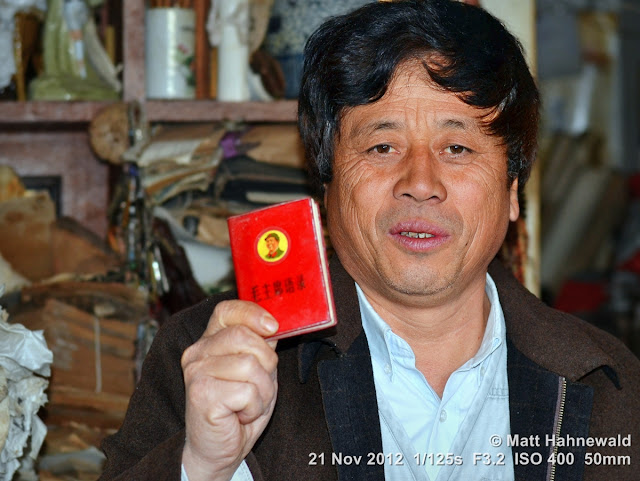Originally, a prop, fka (theatrical) property, is an object used on stage or on screen by actors during a performance or screen production. In practical terms, a prop is considered to be anything
movable or portable on a stage or a set, distinct from the actors, scenery, and costumes. The term comes from live-performance practice, especially theatrical methods, but its modern use extends to film,
television, and photography.
A simple yet highly effective way to animate and spice up an interactive aka posed street portrait is to use impromptu props in the scene. An impromptu prop for interactive street portrait photography would be
anything that the subject owns, holds or touches and/or something near the subject that adds to the story and dimension of the image. Utilising props that mean a great deal and are highly personal to the subject, such as below the Buddhist
prayer wheel, Mao’s Little Red Book, or the sadhu’s walking stick, can make the street portrait more unique and tell a story about that person.
Using props in portrait photography is a simple way to create a strong point of interest in the image. Props can complement the subject and make the picture more visually appealing. Props help
to tell a story, producing a more intriguing photo for the viewer to look at. Cell phones, flowers, umbrellas/parasols, cigarettes/cigars, books/newspapers, food/drinks, musical instruments, cameras and pretty much anything
else that the subject can lay her/his hands on will make a good impromptu prop for interactive aka posed street portraits.
Examples of street portraits "propped-up" with cell phones:
Examples of street portraits "propped-up" with flowers:
Including a prop will add another level for the eye to the process, therefore it is imperative to clean up everything else as much as possible: a tight frame/crop, a clean background/backdrop, and minimal distractions in general. Any prop should always be used to the advantage of portraying the subject. The objects used in the picture should be very convincing for the viewer in understanding the subject; there has to be a reason for the object to appear in the image. This can be done with the help of (i) person-related props, (ii) context-related props, and (iii) time-related props. Of course, the transition from one prop category to the other is gradual.
(i) Person-related props help the viewer to understand the character, personality, mood, attitude and role of the photographed subject:
(ii) Context-related props help the viewer to learn about the subject’s environment, culture, religion, nationality, and/or occupation:
(iii) Time-related props help the viewer to fantasize about the subject’s past or future:
More blog entries depicting impromptu props for street portrait photographs:
- Food/drinks (Slurping Oodles of Noodles, Munching at Donghuamen Nightmarket),
- Umbrellas/parasols (Dancing with the Thai Chinese),
- Musical instruments (Facing Exotic Northern Borneo),
- Pieces of art (Profiling Coconuts on Sulawesi),
- Books/newspapers (Making Decisions in Tamil Nadu).















1 comment:
What a wonderful collection. Loved going through each face and their expressions.
Post a Comment